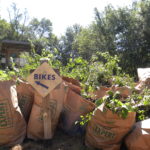Elderberry, hazelnut and pawpaw: Restoration project brings native trees and plants back to bank of Kansas River

photo by: contributed photo
Bags of invasive plant species, mostly honeysuckle and poison ivy, that volunteers removed from the bank of the Kansas River are pictured after a work day in September 2018.
Invasive shrubs and vines once covered a 4-acre stretch along the Kansas River, but now there is room for something else to grow.
Thanks to a local restoration project, those invasive plants have been ripped away, and project leaders are looking for both seeds and helping hands to restore native wildflowers and trees to the area.
Friends of the Kaw, a nonprofit preservation and advocacy group, was awarded a nearly $78,000 Douglas County Natural and Cultural Heritage Grant this summer to help restore native tree and plant species to an approximately 4-acre area north of the river that is also home to the city of Lawrence’s Kansas River trails. With the help of volunteers, invasive species were removed from the bank this fall, making room to restore native species.
“We removed honeysuckle, Chinese privets, winter creeper, poison ivy,” said Courtney Masterson, an ecologist and owner of Native Lands LLC who is involved with the project. “There was an awful lot of coverage of those species. By the time we finished, things looked pretty barren, as expected.”
Friends of the Kaw partnered with Masterson to restore native species to part of the upland vegetated areas along the river, known as the riparian buffer. The buffer should be as wide as the river itself and have deep-rooted native plants and trees that protect against erosion and help stop pollutants from reaching the river.
Friends of the Kaw Riverkeeper Dawn Buehler said that this fall more than 150 volunteers spent close to 400 hours removing the invasive species from the riverbank and beginning the planting process. Buehler said that volunteers ranged widely in age and included high school and undergraduate students.
Masterson said thousands of invasive plants were removed and that 40 trees have already been planted. She said the group plans to plant another 300 trees and additional seeds in the spring.
“There’s a lot of tree loss because of the invasive species, so it will be really nice to improve the quality of that forest through adding live plants and seed,” Masterson said.
A dozen species of native trees will eventually be planted, including black cherry, cottonwood, elderberry, hazelnut and pawpaw. Masterson said that 65 live wildflowers were also planted this fall and that the group seeded the site with more than 30 pounds of seeds representing 42 species of native Kansas plants. Wildflowers planted include woodland phlox, wild ginger, columbine and wild strawberry.
Masterson said the group is also looking for additional donations of native seeds for planting this spring. She said those seeds can be hard to find on the mass market, and that the group is accepting seed donations and will also come out and collect seed from land with native wildflowers or plants.
Buehler said those interested in volunteering to help plant and seed the site can find more information about upcoming workdays and community paddle trips on the Friends of the Kaw Facebook page and website, kansasriver.org. Potential volunteers can also sign up to receive the group’s newsletter, which will also list workdays and events.







